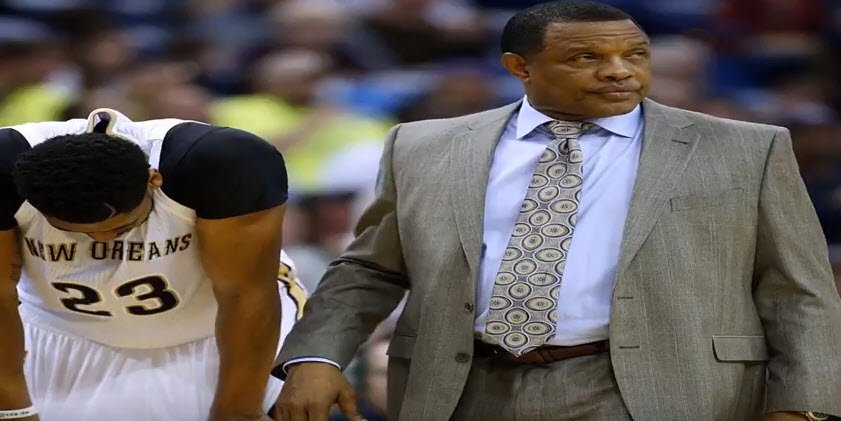Del Harris 25 Defensive Basketball Coaching Thoughts
1. Be a defensive presence at all times! When in the help positions on the weak side, the defenders have to be in a defensive stance with the arms extended reasonably at a level between the shoulders and hips, with the knees flexed, with one hand pointing to the ball and one at their man.
2. Be physical. Make the first hit. Play with body contact first of all. We like to body up, as picks are about to be set. We want to body up on cutters. STAY CONNECTED TO YOUR MAN as he comes off of picks. Do not let him create a big gap between you and him or he will beat you on easy catch and shoots, splits and penetrations.
3. Pressure but still contain the man. Our second front court priority is to prevent your man from “taking the angle toward the goal.” Move your feet and body in order to cut him off. Make him go “East to West”, not “North to South”. This allows the second teammate to give support and still get back to his own man without giving up an easy catch and shoot.
4. Stance. We prefer a position with the inside foot forward (the one nearest the free throw lane) forward and the outside foot back (one nearest the sideline) with his hands at least extended and active, not draped down to his sides. (We do not want to see a defender standing straight up and/or with his hands dropped. That is a sign he needs to come out for a break.)
5. To be good on defense control your man’s first step. It is most difficult to give a defender any help when he gets beat too quickly. We are not fans of overplays anymore, except when we know that a player is so weak to one hand that it makes sense to give that hand. In general players are so much better with the ball now than 10 years ago and before. It puts a lot of pressure on your defense when you encourage any penetration. Take responsibility.
6. But GREAT defense requires that you control the first two steps; after that a good team defense should be there to help. Our first priority is to pressure but still contain the man. Prevent your man from “taking the angle toward the goal” by moving your feet and body in order to cut him off.
7. In our basic 5 man to man defense we want the defenders one pass away from the ball to deny the inside passes aggressively. On the perimeter they must know they are defending their man, but be in a help position, concentrating on making it look crowded to the ballhandler in order to discourage penetration. All players are guarding the ball as well as their man.
8. Challenge every shot possible—our third on-ball priority—deny easy passes in the scoring area–pressure but contain and challenge the shot.
9. When you have good position on the shooter, go straight up but do not leave the floor until he does. Do not foul the jumpshooter. Touch and go to check him off.
10. Work hard to be in position to challenge all 2-point shots so that you can turn and check off the shooter by touching him with the extended hand or forearm (on inside shots) or a checkoff (on outside shots).
11. When you are out of position and a shooter is open above the arc only for a good look at a 3-pointer, run at him and chase him off of the three-line. Otherwise, get to the shooter, but block him out by touching and look for the long rebound.
12. When a teammate gets beat and a man is open for a penetrating jumper inside of 15 feet or for a driving layup, run at him for the blocked shot if you have an angle for the block. A second player may have time then to go for him, if he fakes the first blocker and then continues to try to shoot.
13. If you are not at a block angle or are not a shot-blocker, try to get in front of the defensive arc to take the charge.
14. The ball defender should concentrate on making a quick lunge step on an angle ahead of the penetration angle to cut off the ballhandler and re-establish position. The objective is to prevent the offensive player from “turning the corner” to penetrate an angle directly to the basket.
15. Play defense with the lower body with great foot movement. Work to get the body in front of all dribble penetration attempts by keeping the shoulders below the offensive player’s shoulders. Take the charge, unless you have an angle for a shot-block! Since we are allowed to use the hands to touch and drop so long as we do not impede progress, we can be more active with the hands, but we still want to move the body to be in position to take charges.
16. When a bigger opponent, a 4 or 5 man, begins a drive from 15 or more feet out on the court, a smaller player should see this as an opportunity to step in front of the arc to take the charge, if he is in position to do so when the drive begins. Big men don’t make plays usually.
17. Defend the entry passes to the wing entry position and to the free throw elbow area with a commitment to denial out to the perimeter we establish in our game plan—normally the 3-point line in all of our defenses (or even a step further with some players).
18. Pay particular attention to be able to get out to deny the swing pass to the weak side wing.
19. Trace the ball with active hands to get deflections.
20. We utilize switching on defense against several NBA offensive maneuvers. We like to switch equal size players and often involve our 2-3-4 men in switching with each other—especially in pick/roll games. It is not out of the question for us to have a lineup on the court with which we will say to allow a switch with all five men. Our theory is that mismatches do not beat us; but open shots will.
21. Make switching a positive, aggressive act! Take away something. Switch to deny easy catches and penetration. Switch also to draw the offensive foul. Switching is an aggressive tactic, not a lazy way out of a situation. To us ‘switch and deny‘ is one word.
22. Learn how to use the flop on defense as the offense contacts the defender who is set with good position. This is still a big priority, but now it has to be a legitimate charge. Do not beg for a flop call in the last 2-3 minutes of a close game. The refs won’t give you that call. It must be blatant or else hold your ground.
23. A smaller defender who switches to a big player in a pick and roll will stay between him and the ball until he can pass off the big player to the closest big teammate who can pick him up (except at the end of the clock). This requires talking.
24. Remember the “Red Switch” rule: switch all pick and rolls in the last 5 seconds of the shot clock.
25. We do not like the “fly-by” defense tactic against a 3 point shooter, or any shooter except in one condition–when the shot is taken from a top angle and the defender is so far out of position he is going to give up a shot anyway. By flying by in that situation, he may get an easy quick goal at the other end and may distract the shooter some, who knows he has to release to get back to cover that man. the worst place to “fly-by” is at the low wing and corner angles–running into the stands accomplishes nothing, good shooters are not really bothered and can easily step in to a one-bounce rhythm up shot, but more importantly, the rebound on corner angle shots generally come back to the shooting area. That is they will be short or long and either way, the highest percentage comes straight back to the source. Challenge the shot on a closeout and check the shooter off.
Click on the pdf link to download the basketball coaching clinc notes:




0 Comments